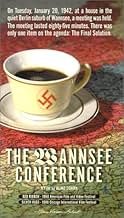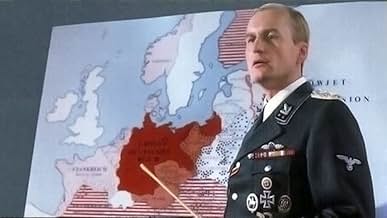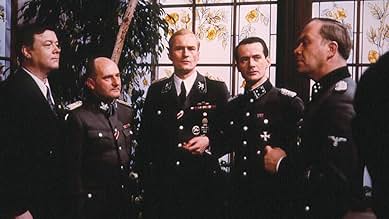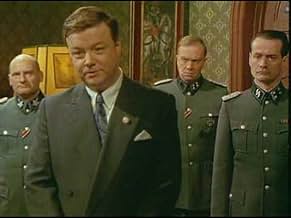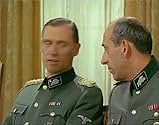IMDb RATING
7.7/10
1.4K
YOUR RATING
At the Wannsee Conference on January 20, 1942, senior Nazi officials meet to determine the manner in which the so-called "Final Solution to the Jewish Question" can be best implemented.At the Wannsee Conference on January 20, 1942, senior Nazi officials meet to determine the manner in which the so-called "Final Solution to the Jewish Question" can be best implemented.At the Wannsee Conference on January 20, 1942, senior Nazi officials meet to determine the manner in which the so-called "Final Solution to the Jewish Question" can be best implemented.
Friedrich G. Beckhaus
- Heinrich Müller
- (as Friedrich Beckhaus)
Hans-Werner Bussinger
- Martin Luther
- (as Hans W. Bussinger)
Werner Asam
- Heydrich's Adjutant
- (uncredited)
- Director
- Writer
- All cast & crew
- Production, box office & more at IMDbPro
Featured reviews
I second the "fly on the wall" comment, this one almost has a cinema verite feel to it. One thing that impressed me was the business-like feel to, no table thumping speeches proclaiming loyalty to the Fuehrer or railing about the "Jewish Problem." Instead a group of second and third rank officials-important cogs in a machine but people little known outside their particular spheres-are discussing how to implement the orders of their superiors. In some respects it's almost like a sales meeting, I recall Heydrich says to one participant "We're taking it off your hands" and at the end he telephones Himmler and says "Our position was accepted across the board.", again, like a sales representative telling his boss that they've won the Big Contract. Frightening way to look at it but that's the way it was.
The one really horrifying film about Shoah. None of the rest, especially Schindler's List, comes anywhere close. In this movie, nobody visibly dies; a roomful of bureaucrats chatters for an hour or so about the most efficient ways to go about the final solution. The ones who seem the worst (Eichmann, Heydrich) meet briefly to talk about co-opting the suckers; the one who seems the best horrifies us by dragging us in to cheering for him when he haggles about saving 70,000 "half-Jews." We are in the depths of Hell when we watch men in clean suits pencil in the details of every horror, pausing only for light refreshment and a bit of shagadelic banter with the babes.
(Note: Over 500 of my movie reviews are now available in my book "Cut to the Chaise Lounge or I Can't Believe I Swallowed the Remote!" Get it at Amazon.)
What I want to do here is to note that The Wannsee Conference is a German language film with white English subtitles. Sometimes the subtitles are superimposed over a white background and the words disappear. That is why state of the art subtitles are yellow so that they don't get lost in the background. Otherwise the subtitles are very good, translating what needs to be translated and ignoring the extraneous.
I also want to note that the somewhat miraculous script by Paul Mommertz is very much like a stage play with most of the action essentially confined to one set with the various players delivering their lines as the camera focuses on them, much as a spotlight might. I say "miraculous" because Mommertz forged his screenplay from the banal, bureaucratic and often euphemistic language used by the historical Nazis as they formulated the so-called "Final Solution." How to make such material dramatic was the problem Mommertz and Director Heinz Schirk faced. They achieved the nearly impossible through the subtle use of what I might call everyday "reality intrusions": the dog barking, the vainglorious Reinhard Heydrich tripping over a briefcase as he is posturing as the grand architect and fuhrer of the Holocaust, the stenographer flirting (and Heydrich's calculated, chilling affirmative response), the greedy drinking, the "Nazi rally" thumping of the table, the turf wars, the boorish jokes, etc. These served to highlight by contrast the horror that these men were so bureaucratically entertaining. Note too that when the stenographer asks if a verbatim report is desired, she is told that a detailed report will suffice. Thus the dumb brute reality could be edited later in a George Orwellian manner to further bureaucratize and euphemize what they were doing.
What a truly verbatim report might have revealed is the point of this film.
This is a work of art, and I want to say that real art, to the extent that it is didactic, fails. If the artist tries to teach a lesson or show us the way and the light through a human story, to that extent he or she loses control and becomes an advertiser, a propagandist, a preacher. We as audience or readers become not participants anymore but objects. A work of art is always a two-way street of participation between the artist and those viewing the art. We might agree with the message or we might not, but we are no longer equal participants in the experience.
Yet what a work of art does is demonstrate a human truth through form. It is almost always an emotional truth. The Greeks emphasized tragedy because they understood the cathartic emotional experience that tragedy brings. What Mommertz and Schirk have done is present the truth as best they could discover it, and then they ran the closing credits. What we as audience experience depends on how well we participated, and what we brought as human beings to the experience. How well we concentrate, how aware we are of what is going on, how alert--these too are important. The Swannsee Conference is a demanding film, but it is surprising how quickly it moves, how engaged we become. The tension is not in what will happen at the end, of course. Instead the tension is in how it happens. We are held in thrall of discovering the essential nature of this most horrific and incredible evil done by the Nazis. And what we find out is that it was above all else banal and bureaucratic.
This is its essence: the dehumanization of the objects upon which the evil is worked. It can be done no other way. It has been said that for good men to do evil it takes religious commitment. For ordinary men it is necessary to dehumanize. When Stuckart complains that women and children are being killed, he is told, "Women and children are Jews too."
What I want to do here is to note that The Wannsee Conference is a German language film with white English subtitles. Sometimes the subtitles are superimposed over a white background and the words disappear. That is why state of the art subtitles are yellow so that they don't get lost in the background. Otherwise the subtitles are very good, translating what needs to be translated and ignoring the extraneous.
I also want to note that the somewhat miraculous script by Paul Mommertz is very much like a stage play with most of the action essentially confined to one set with the various players delivering their lines as the camera focuses on them, much as a spotlight might. I say "miraculous" because Mommertz forged his screenplay from the banal, bureaucratic and often euphemistic language used by the historical Nazis as they formulated the so-called "Final Solution." How to make such material dramatic was the problem Mommertz and Director Heinz Schirk faced. They achieved the nearly impossible through the subtle use of what I might call everyday "reality intrusions": the dog barking, the vainglorious Reinhard Heydrich tripping over a briefcase as he is posturing as the grand architect and fuhrer of the Holocaust, the stenographer flirting (and Heydrich's calculated, chilling affirmative response), the greedy drinking, the "Nazi rally" thumping of the table, the turf wars, the boorish jokes, etc. These served to highlight by contrast the horror that these men were so bureaucratically entertaining. Note too that when the stenographer asks if a verbatim report is desired, she is told that a detailed report will suffice. Thus the dumb brute reality could be edited later in a George Orwellian manner to further bureaucratize and euphemize what they were doing.
What a truly verbatim report might have revealed is the point of this film.
This is a work of art, and I want to say that real art, to the extent that it is didactic, fails. If the artist tries to teach a lesson or show us the way and the light through a human story, to that extent he or she loses control and becomes an advertiser, a propagandist, a preacher. We as audience or readers become not participants anymore but objects. A work of art is always a two-way street of participation between the artist and those viewing the art. We might agree with the message or we might not, but we are no longer equal participants in the experience.
Yet what a work of art does is demonstrate a human truth through form. It is almost always an emotional truth. The Greeks emphasized tragedy because they understood the cathartic emotional experience that tragedy brings. What Mommertz and Schirk have done is present the truth as best they could discover it, and then they ran the closing credits. What we as audience experience depends on how well we participated, and what we brought as human beings to the experience. How well we concentrate, how aware we are of what is going on, how alert--these too are important. The Swannsee Conference is a demanding film, but it is surprising how quickly it moves, how engaged we become. The tension is not in what will happen at the end, of course. Instead the tension is in how it happens. We are held in thrall of discovering the essential nature of this most horrific and incredible evil done by the Nazis. And what we find out is that it was above all else banal and bureaucratic.
This is its essence: the dehumanization of the objects upon which the evil is worked. It can be done no other way. It has been said that for good men to do evil it takes religious commitment. For ordinary men it is necessary to dehumanize. When Stuckart complains that women and children are being killed, he is told, "Women and children are Jews too."
Heinz Schirk masterfully--albeit painfully--captures true Nazi "spirit" as it unfolded at the Wannsee Conference in Berlin, 1942, where the "final solution" was further refined and "perfected." Not only are actors Mattausch, Bockmann, and Beckhaus dead ringers for Heydrich, Eichmann, and Muller, respectively, but Schirk brilliantly highlights the bureaucratization and cold abstraction of Nazi mass murder of the European Jewry.
I was able to see this film at a film festival, where the director spoke afterward about how the film was created. As I had suspected while watching the film, the source for the script was not just the minutes of the meeting, which mention very little of the detailed discussions which occurred that day, but as well what the director called the "Eichmann protocol," that is, transcripts of the interviews conducted by the prosecutors at Eichmann's trial in Jerusalem. Grupenfeurher is correct when he says that the minutes of the conference never mention extermination. But Eichmann's later, extensive, comments prove that that is precisely what was being discussed. For a detailed look at the conference, the best place to begin is Mark Roseman's book, "The Villa, the Lake, and the Meeting: Wansee and the Final Solution." But there are also comments noted in Goebels' diary, and interdepartmenal memos from those who were invited to the conference itself, and much other evidence besides. A good discussion of the process leading to the genocide can be found in Christopher Browning's "Origins of the Final Solution," and a more abbreviated discussion in volume two of Ian Kershaw's biography of Hitler, "Nemesis."
Did you know
- TriviaAt the time of the film's production, SS-Oberführer Dr Gerhard Klopfer was the only living attendee of the Wannsee Conference. He died on January 29, 1987 at the age of 81.
- GoofsAdolf Eichmann is shown in the film wearing a Waffen-SS infantry officer's uniform complete with the SS runes unit patch. Eichmann was in fact a security police colonel and therefore should have displayed a blank security service collar patch with green police piping.
- Quotes
Adolf Eichmann: There were women... children...
Reinhard Heydrich: Women and children are Jews too.
- ConnectionsRemade as La conférence (2022)
Details
- Release date
- Countries of origin
- Languages
- Also known as
- Hitler's Final Solution: The Wannsee Conference
- Filming locations
- Production companies
- See more company credits at IMDbPro
Contribute to this page
Suggest an edit or add missing content

